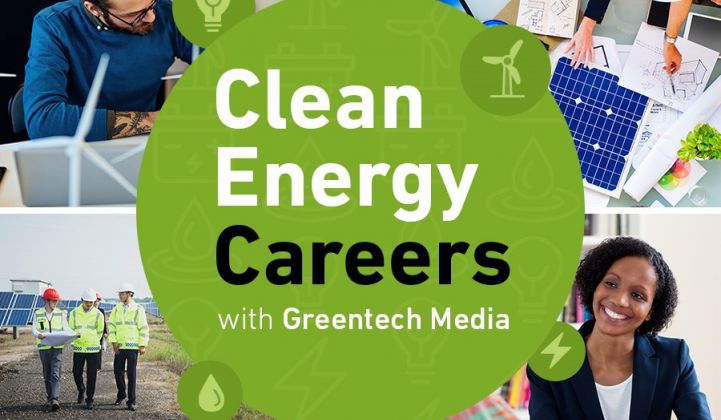In this new GTM series, we're asking people in cleantech to tell us what their jobs are like. We hope the series can serve as a source of information and inspiration for recent graduates, professionals planning their careers or anyone who wants to transition into the industry. We also hope it makes cleantech opportunities more visible and accessible to those groups who are underrepresented in our growing industry, including women and people of color.
What do strategic innovation professionals at utilities do?
As large utilities evolve and modernize, a new type of professional is emerging to oversee the transition. Strategic innovation professionals help drive utilities’ adoption of innovative technologies and business models.
Hilary Pearson, key manager of energy and environmental policy at Exelon Utilities, works in the field. Exelon serves 10 million people and operates six utilities in Illinois, Maryland, Pennsylvania, New Jersey, Delaware and Washington, D.C.
Pearson works with stakeholders inside and outside of Exelon to guide high-level policy developments that can help the utility decarbonize.
As project manager of storage strategy at Con Ed’s Utility of the Future group, Adrienne Lalle examines the economics of energy storage and assesses the role of the utility in deploying storage in New York City. Lalle “determine[s] the best business models to maximize the value of storage, reduce costs and ensure the best value for our grid and customers.”
In a similar position related to electric vehicles, Liz Finnegan managed the Clean Energy Transportation program at Pacific Gas & Electric, which serves 16 million people in California. Finnegan worked to ensure the success of PG&E's programs focused on fleet electrification and competitive EV charging customer programs. (She has since moved on to a different position.)
All of these roles involve helping prepare utilities for a changing mandate: maintaining reliability and affordability, while also integrating cleantech and renewables into their plans for the future.
What skills does a strategic innovation professional at a utility need?
Utilities have complex organizational structures, and coordination between parties can be time-consuming. Strategy professionals at utilities need to communicate clearly and concisely to both peers and senior executives.
“Soft skills such as listening well and being able to understand and communicate big-picture messages are quite important to inform strategic directions of utilities,” said Pearson.
Finnegan's role at PG&E included reporting on flagship programs run by her team and informing senior leadership of the programs’ impact on the utility’s load growth and financial goals.
She also worked with people in other departments and outside of the organization, such as reporting trends in program data and the development of the electric fleet market to the California Public Utilities Commission.
“My past roles in sales gave me confidence in handling profit and loss, and I learned how to effectively communicate to a variety of audiences and understand the importance of customer focus,” said Finnegan. “Learning how to handle rejection and setbacks has also helped me to stay focused on the success of these first-of-a-kind programs with many stakeholders and partners.”
What might people not know about strategy roles at a utility?
Strategic innovation professionals at utilities may not start their careers at a utility — or even in the energy industry. Experience in non-utility sectors can equip professionals with advanced analytical skills to connect the dots among policies, technologies and business models.
Utilities may even prefer a varied professional background when considering candidates. For example, Pearson started her career in politics, working for a U.S. senator. Lalle studied science. Finnegan began her career in business development and sales.
However, a technical understanding of energy, regulation and surrounding issues is still important.
What is your favorite thing about your job?
“Utilities have an essential role in the energy transition. The work here is a combination of mission-driven initiatives and deploying technologies, which makes my job fulfilling,” said Pearson.
Utilities’ decisions about emerging technologies have a material impact on the cleantech industry. The utility workforce is also changing due to the increasing digitalization of the power sector and the fact that a significant portion of the workforce is approaching retirement age.
A new generation of strategy professionals can play a significant role in determining how utilities adapt to a new technology and regulatory landscape in the age of climate change. This potential for impact may appeal to mission-driven professionals.
What are barriers to entry and other limitations that someone interested in this career path might want to be aware of?
Education can be a barrier to pursuing a strategy role at a utility. Hiring managers seeking to fill strategy roles tend to favor advanced degrees, such as MBAs or even doctorates.
As is typical for highly specialized roles in cleantech, however, the right professional experience can also go a long way toward qualifying a candidate.
Additionally, the number of roles in the field is still limited. Not all utilities have robust strategic innovation activities, as the need for such activities is linked closely to the level of such activities in the particular state or utility territory.
But there will be more opportunities in the field as markets for renewables, storage, grid edge technologies and electric vehicles expand.
***
Which jobs in cleantech and renewable energy would you like to know more about? Do you know someone with an interesting job in the field? Drop us a note below. This series is supported by WAGE, an initiative of Wood Mackenzie and GTM.
Fei Wang is a senior grid edge analyst at Wood Mackenzie.
All those quoted in this piece represent themselves only and not their organizations or employers.




